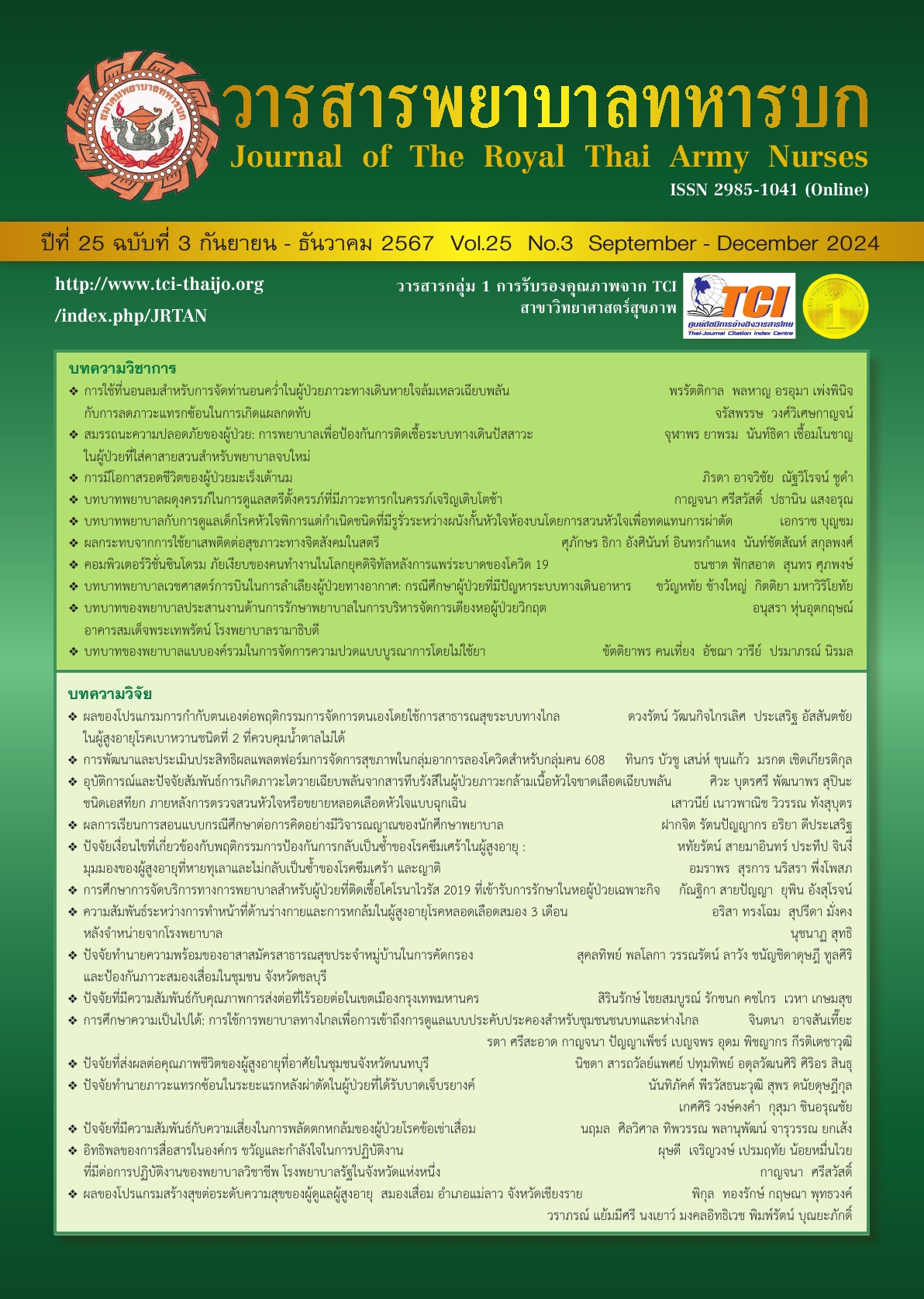Factors Related to Resilience among Primiparous Adolescent with Unplanned Pregnancy
Keywords:
Adolescent, Unplanned Pregnancy, Resilience, Self Esteem, Self Efficacy , Socia SupportAbstract
Primiparous adolescent with unplanned pregnancy must have high resilience to overcome the adversities in pregnancy. This descriptive research aimed to examine the resilience and the factors related to resilience among unplanned primiparous adolescent which included self-esteem, self-efficacy and social support. The sample consisted of 84 women with unplanned primiparous pregnant were under 20 years of age selected by random sampling and attending antenatal clinic at Nakhon Nayok hospital. Data were collected from January to March 2023 by using self report questionnaires which included the Demographic Information Questionnaire, Self-esteem Questionnaire, Perceived Self-efficacy Questionnaire, Social support Questionnaire and Resilience Questionnaire The Cronbach’s alpha coefficients of the questionnaires were .74, .89, .86, .98 respectively. Data were analyzed by descriptive statistics and Spearman’s rank coefficient.
The result revealed that resilience among unplanned primiparous pregnant adolescent was high (M = 103.07, SD = 31.18) and factors with a statistically significantly positive correlated with resilience were self-esteem (r = 0.346, p < .01); self-efficacy (r = 0.415, p < .01) and social support (r = .293, p < .01).
The finding suggested, to strengthen the resilience of unplanned primiparous pregnant adolescent, there is a need for raised awareness of self-esteem, enhancement of self-efficacy combined with family involvement.
Downloads
References
Ministry of public health, Department of health. Statistics on adolescent births in Thailand in 2018. Bangkok : Bureau of Reproductive Health, Ministry of public health;2018. (in Thai)
Vázquez F, Vázquez CF, Saldívar AH, Vázquez EM, Córdova JA, Felizardo J, et al. Unplanned pregnancy in adolescents :association with family structure, employed mother, and female friends with health-risk habits and behaviors. Journal of Urban Health 2014; 91(1):176-85.
Goossens G, Kadji C, & Delvenne V. Teenage pregnancy: a psychological risk for mothers and babies. Psychiatria Danubina. 2015;27(1): 499-503.
Tyrberg RB, Blomberg M, & Kjølhede P. Deliveries among teenage women - with emphasis on incidence and mode of delivery : a Swedish national survey from 1973 to 2010. Biomedcentral Pregnancy Childbirth 2013; 13: 1-10.
Rimárová K, Dorko E, Urdzík P, Houžvicková A, & Argalášová L. Adolescent pregnancy outcomes and risk factors. International Journal of Environmental Research Public Health, 2023; 20(5): 13-41.
Gselamu L, Dagne Y, Gebreyohannes M, & Kelebe A. Psychosocial effects of teenage pregnancy: systematic analysis. Psychology and Behavioral Sciences, 2019;8(5): 18 -115.
Grotberg E. A guide to promoting resilience in children: strengthening the human spirit. Netherland: Bernard van Leer Foundation; 1995.
Karatas Z, & Cakar FS. Self-Esteem and hopelessness, and resiliency: an exploratory study of adolescents in Turkey. Internation Education Studies. 2011;4(4): 84-91.
Ma R, Yang F, Zhang L, Sznajder K, Zou C, Jia Y, et al. Resilience mediates the effect of self-efficacy on symptoms of prenatal anxiety among pregnant women: A nationwide smartphone cross-sectional study in China. Biomedcentral Pregnancy Childbirth 2021; 21: 1-9.
Sagone E, & Caroli ME. Relationships between resilience, self-efficacy, and thinking styles in Italian middle adolescents. Procedia Social and Behavioral Sciences, 2013; 92:45-38.
Maliwan W, Patcharin N, & Sopin S. Factors related to resilience in adolescents. Journal of Psychiatric and Mental Health Nursing.2015;29(1): 57-75. (in Thai)
Wongpakaran A. comparison of reliability and construct validity between the original and revised versions of the Rosenberg self-esteem scale. Psychiatry Investig. 2012;9(1): 54-8.
Wethini S, Atcharee S, & Praphaphon M. Validity of the perception questionnaire in your abilities. Journal Psychiatric Association of Thailand. 2011;47(1): 31-7. (in Thai)
Sinee K, & Jarurat S. Relationships between social support and health promoting behavior among pregnant teenagers. The Journal of Faculty of Nursing Burapha University. 2018; 26(1): 1-10. (in Thai)
Patcharin N, & Sopin S, Tusana T. Factors predicting stress in graduate nursing students. Ramathibodi school of nursing. Mahidol university. Nursing Journal of Ministry of Public Health. 2013;22(3): 1-11. (in Thai)
Kanikaporn B. Factors effecting resilience of unwanted pregnancy teenag girls in Nakhonpathom province dissertation. Bangkok: Silpakorn University; 2012.
Olajubu AO, Omoloye GO, Olajubu TO, % Olowokere AE. Stress and resilience among pregnant teenagers in Ile-Ife, Nigeria. European Journal of Midwifery. 2021; (5): 8-1
Kaur J, & Kaur K. Self- esteem among adolescents in relation to their resilience. Indian Journal of Research. 2017;6(1): 840-1.
Saim NJ, Ghazinour M, & Richter J. Teenage pregnancy in Malaysia: understanding the importance of social support in relation to coping, resilience and mental health. International Journal Recent Technology and Engineering. 2019;8(2) 79-87.
Van Haeken S, Braeken MAKA, Nuyts T, Franck E. Timmermans O, & Bogaerts A. Perinatal resilience for the first 1,000 days of life. Concept and analysis and Delphi survey. Frontiers in Psychology. 2020 ;(11) : 13-1
Maleewan L. Factors Associated with Unwanted Adolescent Women Pregnancy in the Perceived of The First Year Students at Saint Louis College. Journal of The Royal Thai Army Nurses.2014.15(1) : 90-8 (in Thai)
Downloads
Published
How to Cite
Issue
Section
License
Copyright (c) 2024 Journal of The Royal Thai Army Nurses

This work is licensed under a Creative Commons Attribution-NonCommercial-NoDerivatives 4.0 International License.
บทความหรือข้อคิดเห็นใดใดที่ปรากฏในวารสารพยาบาลทหารบกเป็นวรรณกรรมของผู้เขียน ซึ่งบรรณาธิการหรือสมาคมพยาบาลทหารบก ไม่จำเป็นต้องเห็นด้วย
บทความที่ได้รับการตีพิมพ์เป็นลิขสิทธิ์ของวารสารพยาบาลทหารบก
The ideas and opinions expressed in the Journal of The Royal Thai Army Nurses are those of the authors and not necessarily those
of the editor or Royal Thai Army Nurses Association.






